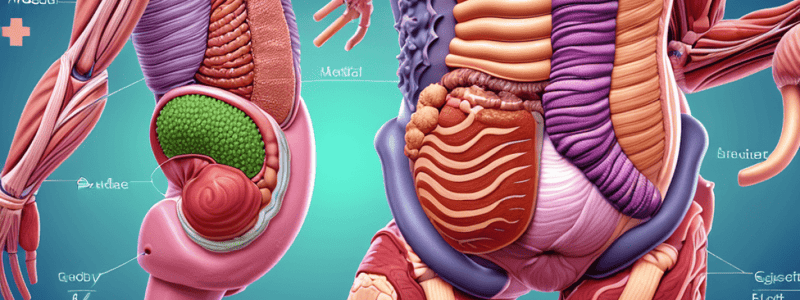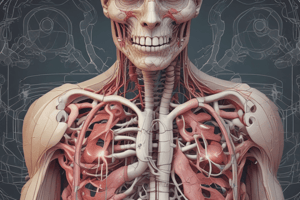Podcast
Questions and Answers
Match the following gastrointestinal anatomy terms with their definitions:
Match the following gastrointestinal anatomy terms with their definitions:
Transverse colon = Travels horizontally across the abdomen and bends to form the descending colon Peristalsis = Rhythmic dilation and contraction of the gastrointestinal tract as food is propelled through it Gastrin = Endocrine hormone released from the stomach; stimulates secretion of gastric acid Meckel’s point = Congenital sac or blind pouch found in the lower portion of the ileum
Match the following sonographic evaluation terms with their definitions:
Match the following sonographic evaluation terms with their definitions:
Abscess = Localized collection of pus surrounded by inflamed tissue Cholecystokinin = Hormone secreted into the blood by the mucosa of the upper small intestine; stimulates contraction of the gallbladder and pancreatic secretion of enzymes McBurney’s point = Located by drawing a line from the right anterosuperior iliac spine to the umbilicus; at approximately the midpoint of this line lies the root of the appendix Secretin = Released from small bowel as antacid; stimulates secretion of bicarbonate
Match the following pathology terms with their definitions:
Match the following pathology terms with their definitions:
Appendicolith = Calcified deposit within the appendix; appendicitis can develop when the appendix becomes blocked by hard fecal matter Diverticulum = Pouchlike herniation through the muscular wall of a tubular organ that occurs in the stomach, the small intestine or, most commonly, the colon Hemorrhage = Collection of blood Target sign = Characteristic of gastrointestinal wall thickening consisting of an echogenic center and a hypoechoic rim
Match the following anatomy terms with their definitions:
Match the following anatomy terms with their definitions:
Match the following anatomy terms with their definitions:
Match the following anatomy terms with their definitions:
Match the following anatomy terms with their definitions:
Match the following anatomy terms with their definitions:
Match the following anatomy terms with their definitions:
Match the following anatomy terms with their definitions:
Match the following anatomy terms with their definitions:
Match the following anatomy terms with their definitions:
Match the following anatomy terms with their definitions:
Match the following anatomy terms with their definitions:
What is the function of the greater omentum?
What is the function of the greater omentum?
Where is the cardiac orifice located?
Where is the cardiac orifice located?
What are valvulae conniventes?
What are valvulae conniventes?
What is the primary role of the hepatic flexure?
What is the primary role of the hepatic flexure?
What does the mesothelium refer to in the gastrointestinal tract?
What does the mesothelium refer to in the gastrointestinal tract?
Which structure forms the pyloric canal?
Which structure forms the pyloric canal?
What is the function of cholecystokinin?
What is the function of cholecystokinin?
Where is McBurney’s point located?
Where is McBurney’s point located?
What is Meckel’s diverticulum?
What is Meckel’s diverticulum?
What does an appendicolith refer to?
What does an appendicolith refer to?
What is paralytic ileus?
What is paralytic ileus?
What is ascites?
What is ascites?
What does a polyp refer to?
What does a polyp refer to?
What is diverticulum?
What is diverticulum?
What does hemorrhage refer to?
What does hemorrhage refer to?
What is lymphoma?
What is lymphoma?
What does secretin do?
What does secretin do?




